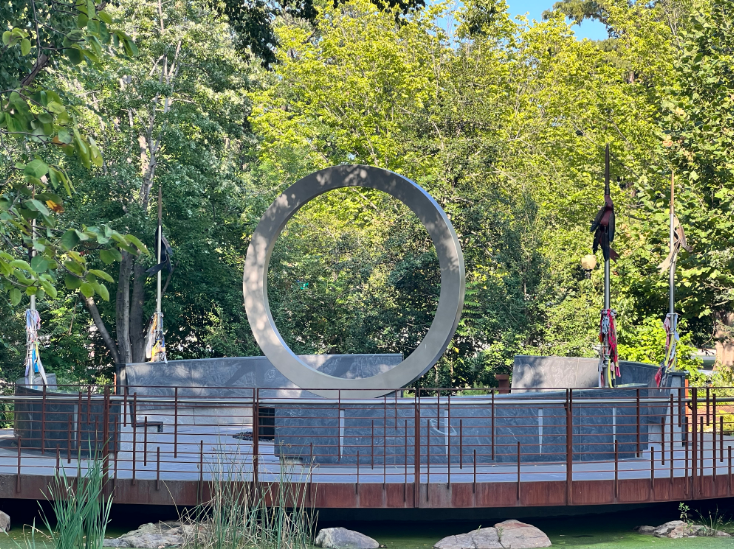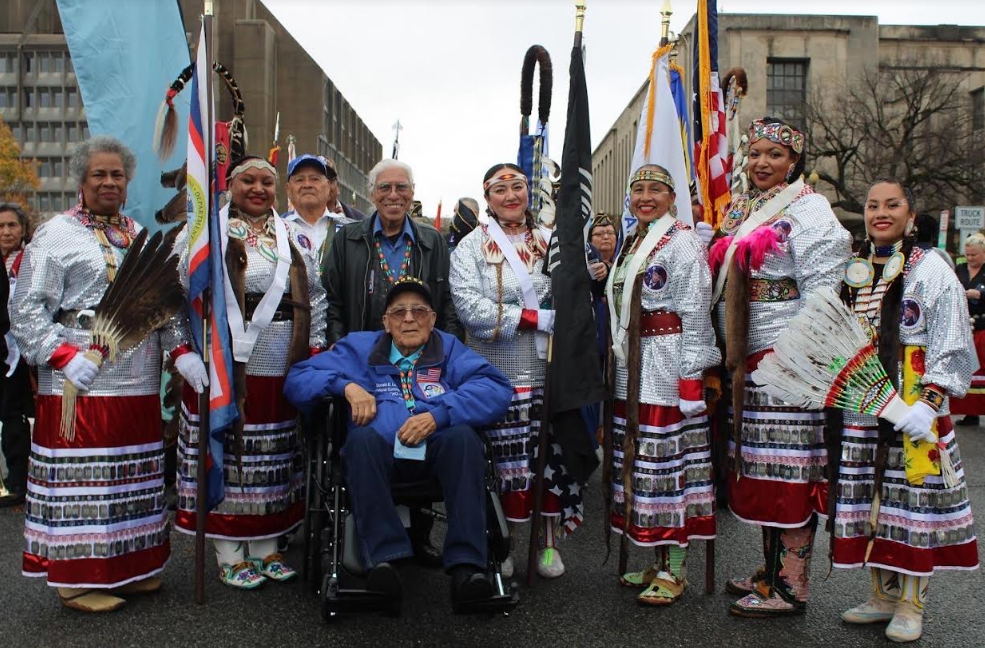
- Details
- By Darren Thompson
WASHINGTON — For over 1,500 American Indian, Alaska Native, and Native Hawaiian veterans who were on hand for the dedication of the National Native American Veterans Memorial in Washington, D.C. on Friday, it is one Veterans Day they will remember for the rest of their lives.
On Friday, the National Museum of the American Indian hosted a grand procession and ceremony for the dedication of the National Native American Veterans Memorial. The 1,500 Native veterans participated in a grand procession through the National Mall.
Michael Coon traveled with a group of veterans from the Muscogee Creek Nation from Oklahoma and had tears of joy in participating in the grand procession for the National Native American Veterans Memorial.
“It is an honor to be here with all of our brothers and sisters in the military family,” Coon said. “I look forward to having camaraderie with all of my brothers and sisters as we show the world how strong we are when our call comes to serve this nation.”
His father, Philip Coon, was a prisoner of war in the Pacific Theater during World War II and survivor of the Bataan Death March.
The event was co-emceed by Retired Captain of the U.S. Navy John Herrington (Chickasaw), the first Native American astronaut to go into space, and Retired Sergeant of the U.S. Army Wes Studi (Cherokee), who is an Academy Award-winner. Studi served 12 months in the Vietnam War and was honorably discharged by the U.S. Army in 1969.
“A Native American on any battlefield is a formidable force to be reckoned with,” Studi said. Studi expanded on his comment by discussing the football competition in 1912 between West Point Academy and the Carlisle Indians.

“This historical rivalry pitted a 22-year-old linebacker named Dwight D. Eisenhower—he was the 34th President of the United States of the United States—against the real all-American team that was led by Jim Thorpe,” Studi said.
“Eisenhower said, ‘here and there, there are some people who are supremely talented and my memory goes back to Jim Thorpe,’” Studi said of Eisenhower’s comments on Jim Thorpe once he was president. “He could do anything better than any football player I ever saw.”
The National Native Americans Veterans Memorial’s design is an elevated stainless-steel circle balanced on a carved stone drum on the campus of the Smithsonian’s National Museum of the American Indian. The design was created by Harvey Pratt, a Vietnam War veteran and Cheyenne and Arapaho Tribes of Oklahoma citizen. The design incorporates water for ceremonies, benches for gathering and reflection, and four lances where people can tie prayer cloths for offerings and reflection.
“I want to look at the heavens today, the Creator gave us a nice gentle rain, to water Mother Earth, and for us to start a new day,” said Harvey Pratt during Friday’s dedication to the National Native American Veterans Memorial. “This memorial came about in a dream, as I gather all of my life experiences as a Southern Cheyenne Peace Chief.”

“We created a path of life, a warrior’s circle of honor, lances with sacred colors and prayer clothes, water, the air, the earth, and fire,” said Pratt. “I want to thank the Creator, for creation warriors—without them, we may not be here.”
The memorial honors Native American veterans and their families, and educates the public about their extraordinary contributions. The memorial is the first national landmark in the nation’s capital to commemorate the military contributions of American Indians, Alaskan Natives and Native Hawaiians. According to the Smithsonian, Native Americans’ service in the United States military began at the Revolutionary War, in 1775.
The afternoon dedication included various presenters, including Congresswoman Sharice Davids (Ho-Chunk Nation), Secretary of the Smithsonian Lonnie Bunch III, former National Congress of American Indians president Jefferson Keel (Chickasaw), and several others in the federal government and various branches of the military.
“We are proud to host the National Native American Veterans Memorial at the National Museum of the American Indian for time immemorial,” said Secretary of the Smithsonian Lonnie Bunch III during Friday’s dedication.
The Smithsonian’s National Museum of the American Indian curated a weekend of events on Saturday and Sunday including music, film, food, and celebration at the museum. Veterans in attendance included Daniel Loudner, Hunkpati Dakota national commander of the American Indian Veterans Association and one of the last living Navajo Code Talkers, Thomas Begay.
All photos: Native News Online - Darren Thompson
https://nativenewsonline.net/currents/over-1-500-native-veterans-participate-in-dedication-ceremony-for-the-national-native-american-veterans-memorial#sigProId82f7c78d91
More Stories Like This
Native News Weekly (August 25, 2024): D.C. BriefsUS Presidents in Their Own Words Concerning American Indians
Federal Judge Orders ICE to Halt Use of Pepper Spray, Arrests of Peaceful Protesters in Twin Cities
Tunica-Biloxi Cultural Leader John D. Barbry Walks On
Next on Native Bidaské: Federal ICE Activity in Minneapolis: Ruth Buffalo’s Perspective
Help us defend tribal sovereignty.
At Native News Online, our mission is rooted in telling the stories that strengthen sovereignty and uplift Indigenous voices — not just at year’s end, but every single day.
Because of your generosity last year, we were able to keep our reporters on the ground in tribal communities, at national gatherings and in the halls of Congress — covering the issues that matter most to Indian Country: sovereignty, culture, education, health and economic opportunity.
That support sustained us through a tough year in 2025. Now, as we look to the year ahead, we need your help right now to ensure warrior journalism remains strong — reporting that defends tribal sovereignty, amplifies Native truth, and holds power accountable.
 The stakes couldn't be higher. Your support keeps Native voices heard, Native stories told and Native sovereignty defended.
The stakes couldn't be higher. Your support keeps Native voices heard, Native stories told and Native sovereignty defended.
Stand with Warrior Journalism today.
Levi Rickert (Potawatomi), Editor & Publisher


